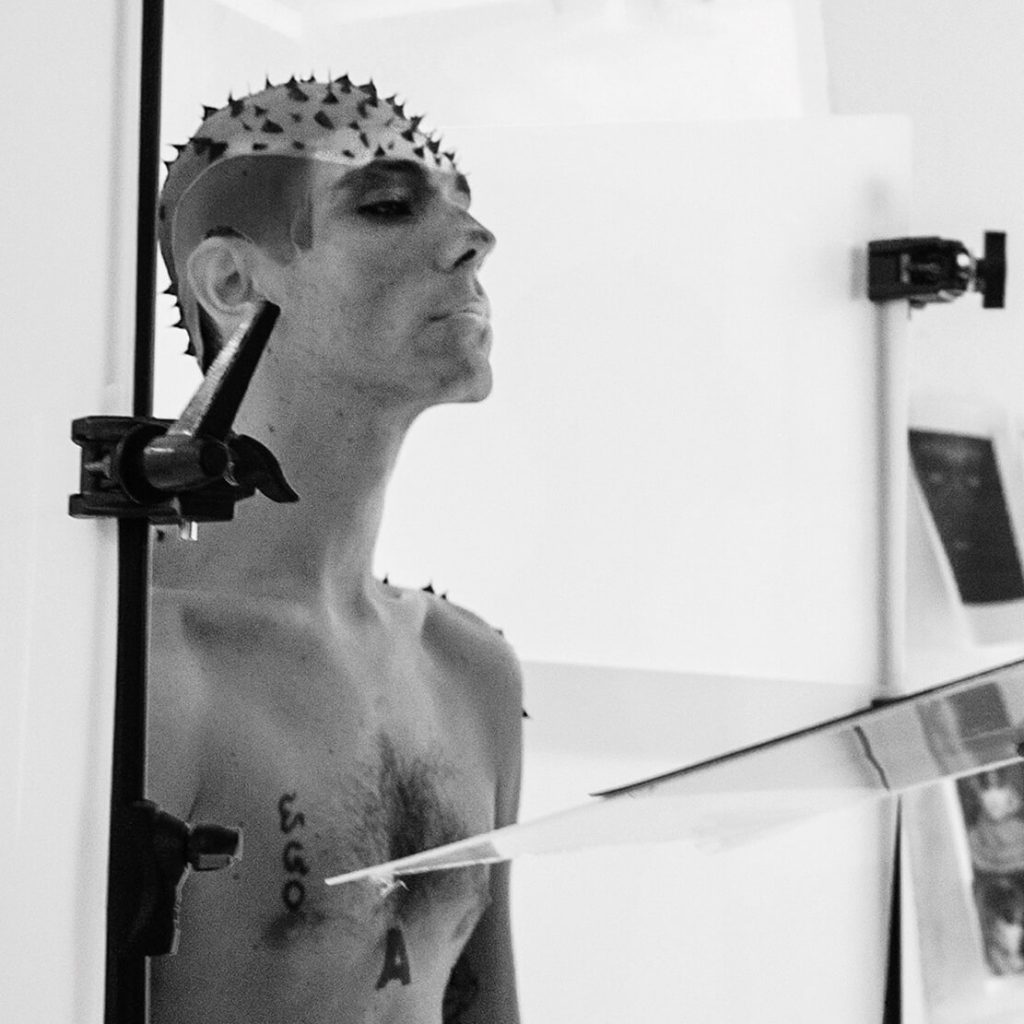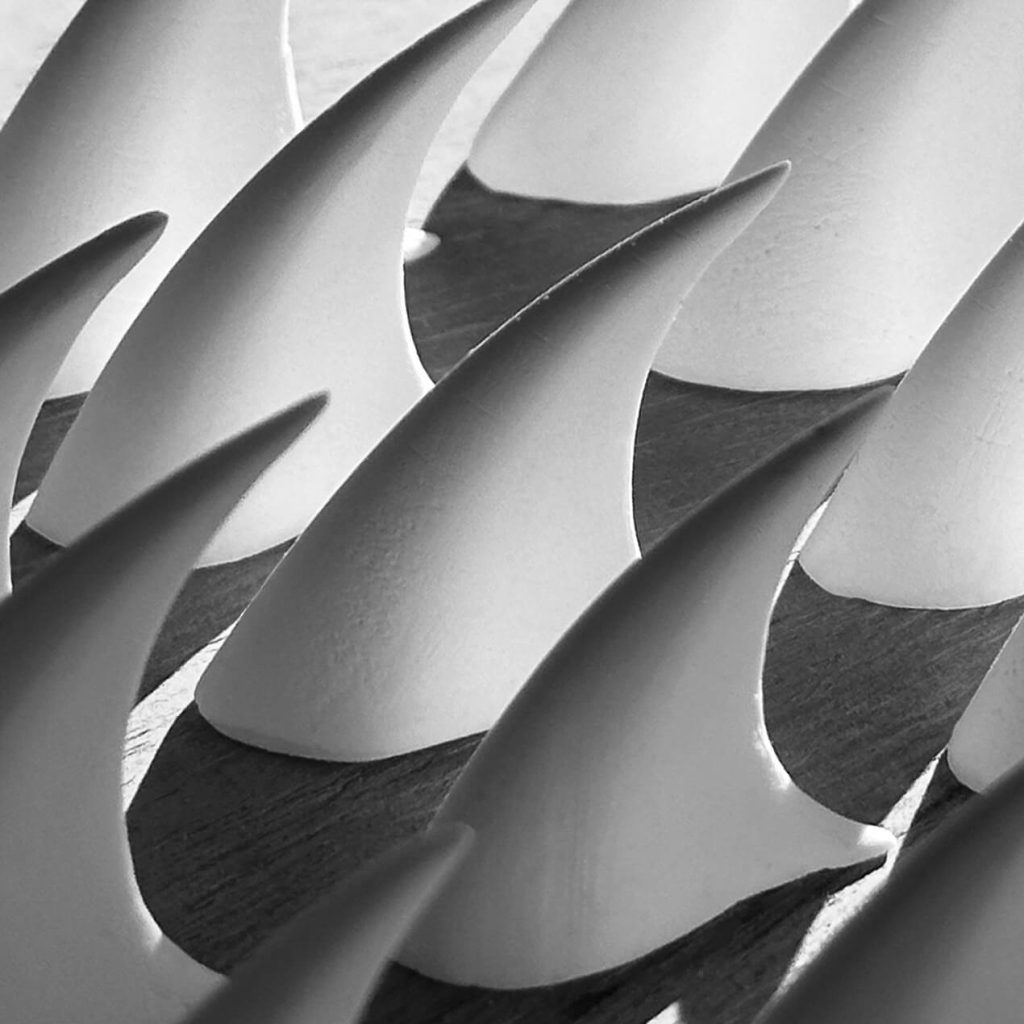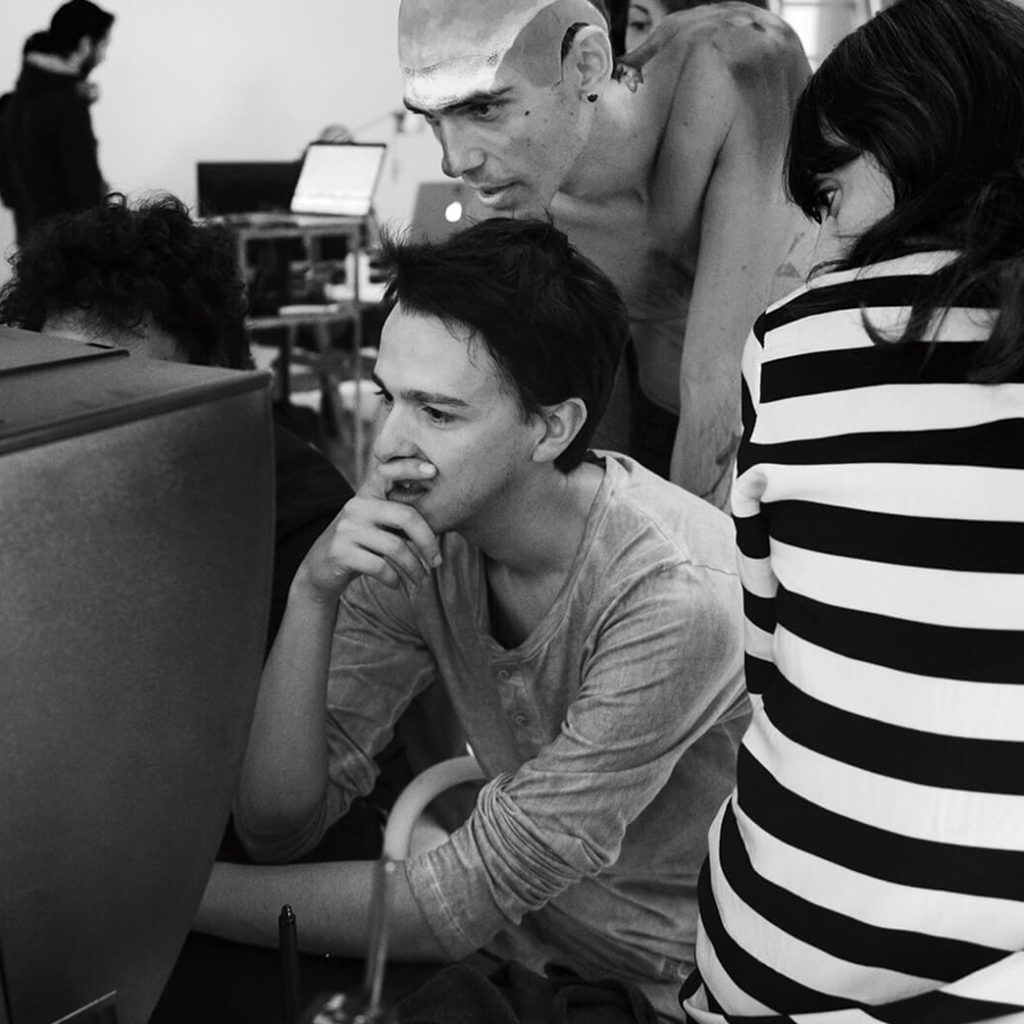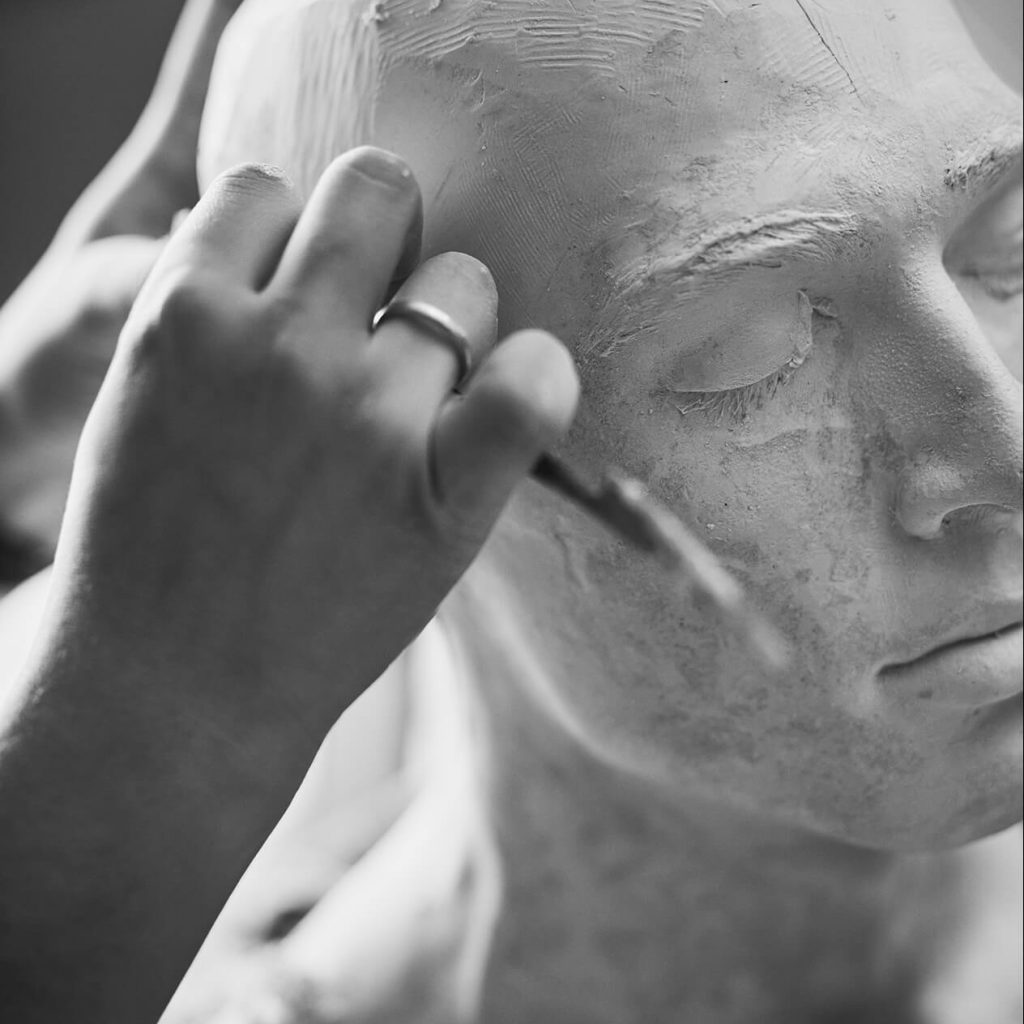Volti
Low Tech Body Props





THE VOLTI
SERIES
A conversation with
Mattia Voso
This book was published a staggering fourteen years after the first shooting that gave rise to the Volti series by Mattia Voso, a project that is being showcased in its entirety for the first time.
We meet the photographer to better understand the origins and evolution of the series over time.
You were born and raised in Florence, the city where you live and work, and where you have built your professional career. Tell us how you took your initial steps and how the context you faced influenced or helped you.
Cyborg I and II was the first face photographed, if I remember correctly, in 2009. Could you elaborate on this starting point?
During that time, I started working with unconventional materials and then applying them to the human body. After completing a photo shoot, I often liked to spend time experimenting with new lighting schemes, materials, and props on the models. This process gradually became a sort of “ritual” to repeat at the end of each set. Cyborg I and II originated from one of these experiments: by modeling grey plastic material, I created a prop to hide the model’s hair. I wanted to replicate this process in multiple artworks since I immediately realized that by concealing subjects’ hair, the interpretation of the image became less defined, and made it more challenging, for example, to attribute a gender to the subject or place it in a specific historical period.
Your background with a Master's Degree in Statistics seems apparently unrelated to your professional path as a photographer. What are your thoughts on this?
You started shooting the Volti series at the same time you pursued your career as an advertising photographer. Over the years, how have you managed to balance these two worlds, and how do you think they have influenced each other?
The series consists of the portraits of nine faces, resulting from as many photo shoots that I personally directed over the past fourteen years. During this time, I have had the opportunity to experience many different situations, leading to significant professional and personal growth. Managing a set, handling lighting arrangements, and maintaining relationships with clients and models, are just a few of the aspects that I have had to deal with. Furthermore, my working team has significantly expanded over time, enabling me to tap into different experiences and sensibilities, enriching my personal knowledge significantly.
What I gradually learned from commissioned shoots was transferred into the Volti experience and vice versa. My constant and progressive professional growth, the development of new work techniques, an increasingly refined aesthetic sensitivity, and the continuous expansion of my network are all elements that have inevitably reflected and influenced the development of the Volti series. On the other hand, the experiments, creative freedom, and teamwork that marked the various sets of the series have undoubtedly produced their own spillover effects in commercial services. Alternating between commissioned work and the Volti sets has always been exciting and motivating for both me and the entire team.
Key elements of the series are the "Low-Tech Body Props" (props), unusual clothes, prosthetics, and masks that characterize the Volti. How do these props come to life, and what is your approach to the materials you use?
Usually, I have a specific object and material in mind that I want to apply and explore on a body. The initial step involves understanding the potential interaction between that particular shape or material and the human figure. This involves tests, sometimes rough, either on myself or a team member. This phase is undoubtedly the most enjoyable as it allows for experimentation, manipulation, and pushing an element or material into certain unconventional positions or shapes. This moment is crucial for understanding and analysing the physical sensation the model will experience on the set, as well as determining their range of possible movements. From here, I proceed to the realization of the final Low-Tech Body Prop and, once I have achieved the desired aesthetic and functional result, I start organizing the actual photo shoot.
Following the various ideas and visions that I had in mind, it often happened that the various design phases overlapped in time, leading me to work on several subjects simultaneously. For King I and II, the creation of the Low-Tech Body Props started with actual black-painted rose thorns, and were studied for their application on the human body. These thorns were then adapted for creating the King sculpture. However, in this case, the process was different since I used 3D printing to obtain new thorns inspired by the originals, which I then used for the realization of the sculpture. It is worth noting that this occurred in 2023, approximately 10 years after the King I and II shoot.
Even in the images Queen I and II, a mask with a sci-fi look but not easily identifiable appears.
In front of some Volti images, the spectator might be misled or uncertain whether they are facing a real photographic portrait or an image altered through computer graphics. Is this effect intentional? Can you explain how these two dimensions interact within the series?
For me, the series collects “portraits of human faces” born from my imagination. Expressiveness, uniqueness, and realism of the human face are pivotal elements in all my artworks and the realization of each piece. However, in some cases, when representing one of my ideas wasn’t achievable merely by capturing the “real” from the set, I had to resort to computer graphics to overcome certain obstacles. For example, in Metal, the subject’s crest consisted of liquid iron, a toxic substance for human skin, making direct application on the model impossible. Thus, this prop was photographed separately and then digitally applied to the subject. Another instance of an image that required a graphic retouching phase is clearly Black Man I, where, for obvious reasons, the visible ear in the subject’s mouth was separately photographed and then inserted into the model’s shot.
The balance between the two worlds, digital and real, remains however always indispensable. When an artwork manages to confuse the viewer, I feel I have achieved one of my primary objectives.
We have discussed materials and props, but what role do human subjects play within the series?
The subjects play a key role in Volti since they are the main protagonists interpreting the depicted scene. I don’t follow constant and fixed rules in selecting subjects. Sometimes, while on the set of a commissioned work, I might be struck by a model, whom I then envision within the series. Other times, however, as in Alchemist I and II, I already have in mind the subject that I want to portray and proceed directly with precise research.
Their role is fundamental: they interpret and give life to the envisioned Volto. It is on their skin that the various materials are modeled, they wear the Low-Tech Body Props. It is only through their gaze that I manage to conclude the creative process and have the feeling that the Volto is finally “alive”!
When we first met in your studio, I had the opportunity to see King and Black Spikes sculptures in person. How would you place these two works within the series?
Over the years, I have preserved all the Low-Tech Body Props created for the various Volti shoots. They represent a living testimony of the interaction between the artificial world and the real subjects on the set, as well as of the imagination from which they originated. I have concretely reproduced this encounter in space, offering studio visitors the opportunity to directly observe how these props were plastically applied to the human body.
Over approximately two years, with the contribution of a sculptor artist, I managed to obtain plaster and resin busts, using the real cast of a person, to which some of the Low-Tech Body Props were then applied. The Black Spikes sculpture involves a mask composed of iron and 2 kg of steel spikes, whereas, for King, I first applied UV paint on which 128 black resin spikes were then affixed. Both sculptures replicate the application process and, consequently, the final effect of the Volto for which the props were conceived
What did you notice when showing your photographs?
I am always very focused on observing people’s reactions when they face the series. What I have noticed most frequently is that observers don’t immediately know how to react to the gaze of a Volto. I believe there is an instinctive uncertainty, a doubt in comprehending and concentrating on what they are seeing. I think the observer associates a material, a prop, a colour, a light, or a look with something personal, trying to figure out which emotion, stimulus, or feeling might be most appropriate. There may emerge a sort of initial resistance that, once overcome, leads to an interaction with the artwork, generating a strong curiosity that transcends the need to classify and label everything based on existing patterns and superstructures. If this happens, I feel I have achieved my main goal.
Do you think you can stop portraying the Volti?







